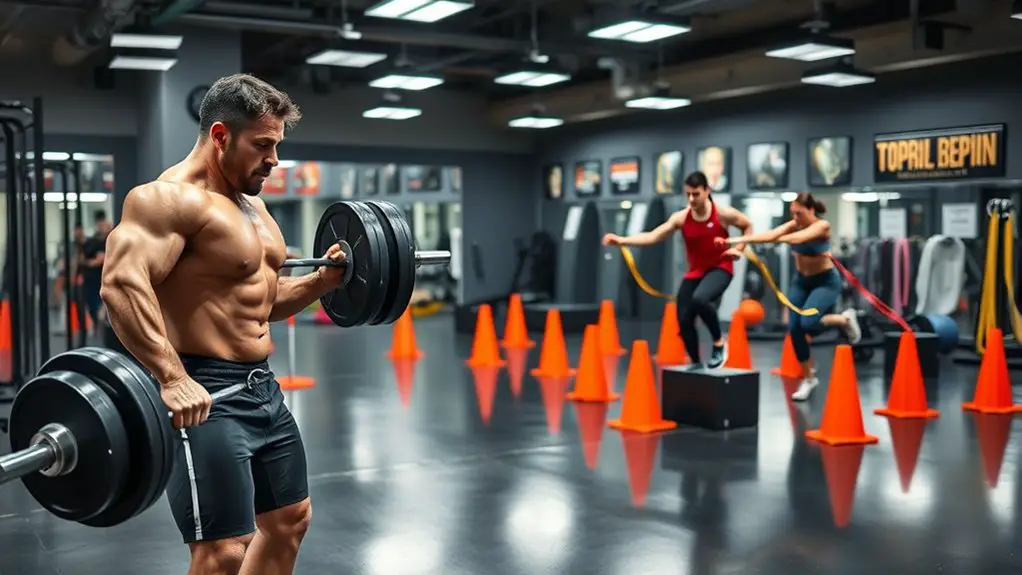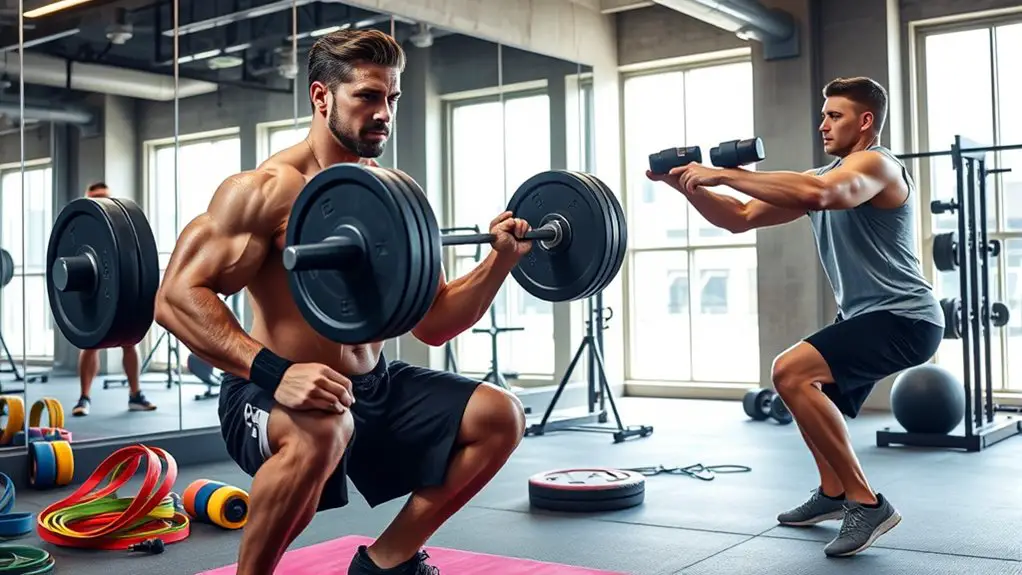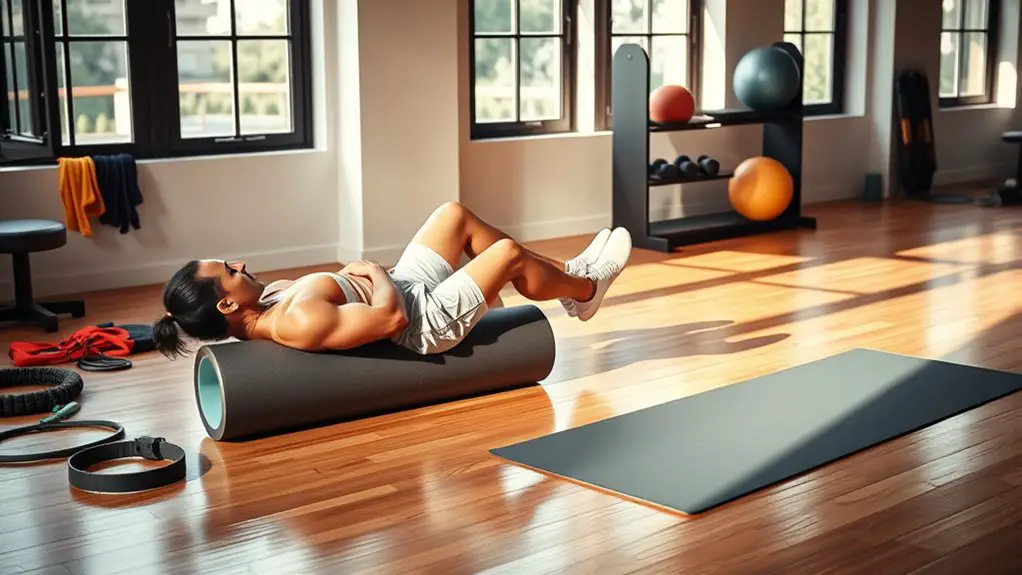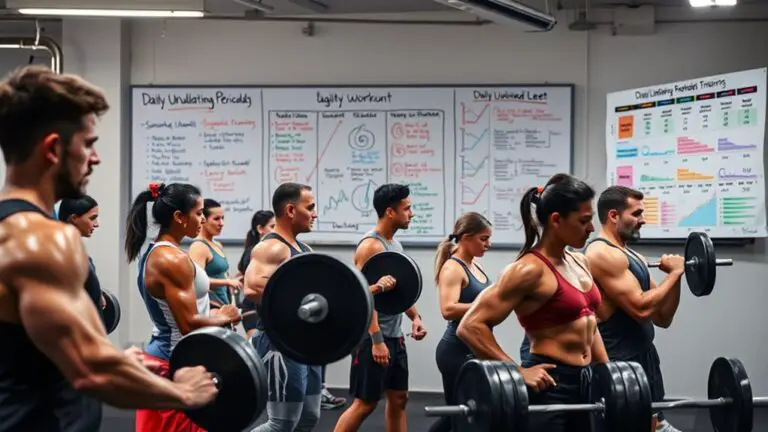How to Train Like a Pro Athlete at the Gym

To train like a pro athlete at the gym, start by setting clear, measurable goals. Design a balanced workout plan that includes cardio, strength training, and flexibility exercises. Incorporate strength and conditioning drills while focusing on proper nutrition, prioritizing whole foods and hydration. Don’t forget about recovery techniques to keep your body in top shape. As you progress, tracking your improvements keeps you motivated and accountable; there’s even more to enhance your training journey.
Setting Clear Goals for Your Training

When you set clear goals for your training, you’re not just giving yourself a destination; you’re also creating a roadmap to get there. This process starts with goal visualization, where you picture your desired outcomes, whether it’s building strength, improving endurance, or mastering a new skill. By visualizing these goals, you make them feel more attainable.
Next, establish performance benchmarks. These are measurable milestones that help you track your progress safely and effectively. Instead of overwhelming yourself with a massive goal, break it down into smaller, achievable steps. Each benchmark reached not only boosts your confidence but also reinforces your commitment to your training.
Designing a Balanced Workout Plan
To achieve ideal results, it’s vital to design a balanced workout plan that addresses all aspects of fitness. Start by incorporating cardio, strength training, and flexibility exercises into your routine. This variety not only keeps your workouts engaging but also maximizes cross training benefits, reducing the risk of injury while improving overall performance.
Aim for at least three days of cardio, two days of strength training, and regular flexibility sessions. Consider workout variations, such as alternating between high-intensity interval training and steady-state cardio, or mixing bodyweight exercises with weights. This approach guarantees that all muscle groups are targeted while preventing burnout and plateaus.
Incorporating exercises like skipping rope can provide both aerobic and anaerobic benefits, enhancing your overall fitness. Listen to your body and adjust your plan as needed to prioritize safety. By designing a well-rounded workout, you’ll build endurance, strength, and flexibility, setting the foundation for your fitness journey.
Incorporating Strength and Conditioning Exercises

Incorporating strength and conditioning exercises into your routine can greatly enhance your athletic performance, as these workouts focus on building muscle, improving power, and increasing endurance. Start with basic strength techniques like squats, deadlifts, and bench presses. These compound movements engage multiple muscle groups and promote overall stability. Always prioritize proper form to prevent injury—consider working with a trainer if you’re unsure.
Next, integrate conditioning drills like sprints, agility ladders, or plyometric exercises. These drills boost your cardiovascular fitness and enhance your athletic ability. Aim for a balanced mix of strength and conditioning sessions throughout the week, ensuring you allow adequate recovery for your muscles.
Don’t forget to listen to your body. If you feel fatigued or experience pain, take a step back. Gradually increasing intensity will help you progress safely while minimizing the risk of injury.
Emphasizing Proper Nutrition
Strength and conditioning workouts are just one piece of the puzzle in achieving peak athletic performance; nutrition plays a vital role too. To fuel your body efficiently, focus on meal timing and nutrient density. Eating balanced meals at regular intervals helps maintain energy levels and supports recovery. Aim to consume a mix of carbohydrates, proteins, and healthy fats to optimize your workouts.
Consider eating a nutrient-dense meal or snack within 30 to 60 minutes post-exercise to replenish glycogen stores and repair muscles. Prioritize whole foods like fruits, vegetables, lean proteins, and whole grains, as they provide essential vitamins and minerals that support overall health.
Stay hydrated as well; water is essential for performance and recovery. By paying attention to what and when you eat, you’ll set yourself up for success in the gym and beyond, ensuring your body has the fuel it needs to perform at its best.
Mastering Recovery Techniques

While training hard is essential, mastering recovery techniques is equally important for enhancing your athletic performance. Incorporating active recovery days into your routine can greatly improve your body’s ability to bounce back. This might include light activities like walking, swimming, or yoga, which keep your muscles engaged without overexerting them.
Another key component is foam rolling. This technique helps release muscle tightness and improve blood flow, promoting better recovery. Spend a few minutes rolling out major muscle groups after workouts, focusing on any areas that feel particularly tight or sore.
Don’t underestimate the power of rest, too. Ensuring you get adequate sleep allows your body to repair and rebuild. By prioritizing these recovery methods, you’ll not only reduce the risk of injury but also optimize your performance in the long run. Remember, recovery is just as crucial as the training itself. Additionally, staying hydrated after intense workouts and massages can significantly aid in muscle recovery.
Tracking Progress and Staying Motivated
To train like a pro athlete, you need to track your progress and stay motivated. Start by setting clear goals and using progress journals to monitor your improvements. Don’t forget to celebrate those small wins along the way; they’re key to keeping your spirits high! Additionally, consistent effort towards goals is crucial for recognizing your achievements and ensuring you’re making progress in your fitness journey.
Set Clear Goals
Setting clear goals is essential for maintaining motivation and tracking progress in your athletic journey. Start by practicing goal visualization—picture yourself achieving your targets, whether it’s lifting heavier weights or completing a challenging workout. This mental exercise can boost your confidence and focus. Next, establish goal accountability; share your objectives with a friend or coach who can help keep you on track. Regular check-ins can provide encouragement and constructive feedback, ensuring you stay aligned with your fitness aspirations. Remember, it’s important to set realistic, measurable goals that prioritize safety over competition. By doing so, you’ll not only enhance your performance but also enjoy the process of becoming a better athlete. Keep your goals clear, and you’ll stay motivated!
Use Progress Journals
Once you’ve established clear goals, tracking your progress becomes essential in maintaining motivation. Using a progress journal allows you to document your workouts, noting improvements in strength, endurance, and overall performance. This method isn’t just about numbers; it’s a tool for performance analysis that helps you identify what works and what needs adjustment. By regularly reviewing your entries, you can celebrate your gains while also recognizing any plateaus. This reflection keeps you accountable and encourages safe training practices. Additionally, it helps you stay focused on your journey, reminding you of your commitment to personal growth. So, grab a notebook or an app, and start your progress tracking today to enhance your gym experience!
Celebrate Small Wins
Celebrating small wins is essential in your journey to becoming a pro athlete. It helps you stay motivated and reinforces your progress. Recognizing these milestones can make a big difference in your training routine. Here are some ways to celebrate:
- Set Mini-Goals: Break your larger goals into smaller, achievable tasks.
- Track Your Progress: Use a journal or app to visualize your improvements.
- Reward Yourself: Treat yourself to something enjoyable, like a favorite snack or a rest day.
- Share Achievements: Discuss your progress with friends or a coach for positive reinforcement.
Frequently Asked Questions
What Should I Wear to Train Like a Pro Athlete?
When you’re deciding what to wear for training, consider performance apparel that enhances your movement and supports your body. Look for moisture-wicking fabrics to keep you dry and comfortable. Your footwear selection is just as essential; choose shoes that provide proper support and traction to prevent injuries. Don’t forget to wear layered clothing to adapt to temperature changes, ensuring you stay safe and focused throughout your workout.
How Often Should I Change My Workout Routine?
You should change your workout routine every 4 to 6 weeks to maintain workout variability and prevent plateaus. This keeps your body challenged and engaged, reducing the risk of injury. Incorporating training periodization can help you gradually increase intensity and volume while allowing for recovery. Listen to your body; if you’re feeling fatigued or bored, it’s time to switch things up. Consistency is essential, but variety keeps your training effective and enjoyable.
Can I Train Like a Pro at Home?
You can absolutely train like a pro at home, and it doesn’t require a magic gym! With bodyweight exercises, you can sculpt your physique into something that could rival an Olympian. Just grab some basic home equipment like dumbbells or resistance bands to elevate your routine. Always prioritize safety, though; make certain you’re using proper form to avoid injuries. So, release your inner athlete and transform your living room into a training ground!
What Supplements Do Pro Athletes Take?
Pro athletes often use supplements to enhance performance and recovery. You might consider protein powders for muscle repair, while creatine monohydrate can boost strength and endurance. Omega-3 fatty acids are great for reducing inflammation, and branched-chain amino acids (BCAAs) can help with muscle recovery. However, it’s essential to consult a healthcare professional before starting any supplement regimen, ensuring safety and that they align with your fitness goals.
How Do I Avoid Injuries While Training?
To avoid injuries while training, it’s vital to prioritize injury prevention. Start with proper warm-up routines to prepare your muscles and joints for the workout ahead. Incorporate dynamic stretches and light cardio to increase blood flow. Listen to your body; if something feels off, don’t push through the pain. Gradually increase intensity and be mindful of your form. Staying hydrated and allowing adequate recovery time are also essential to keep you safe and injury-free.





